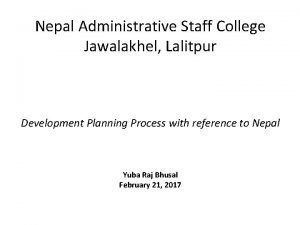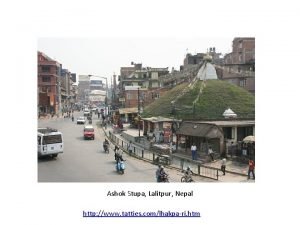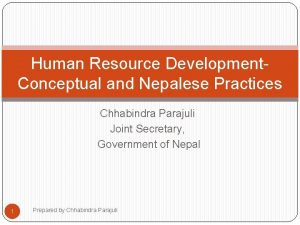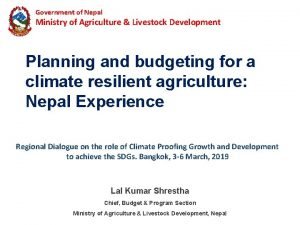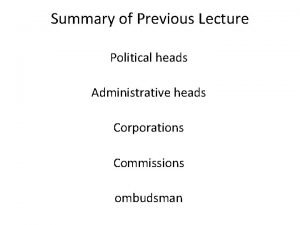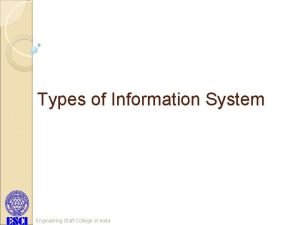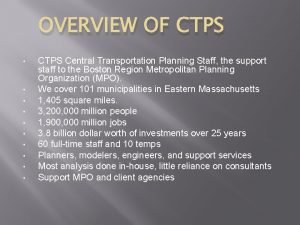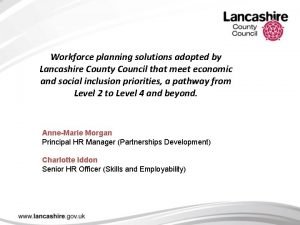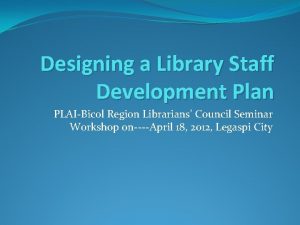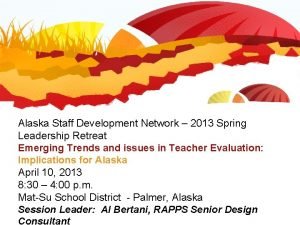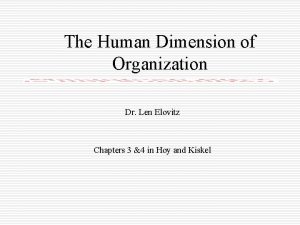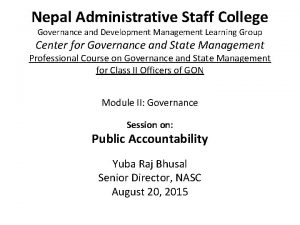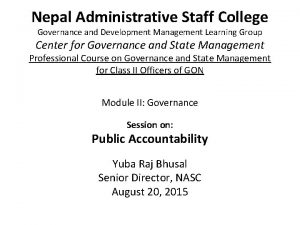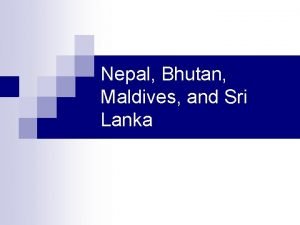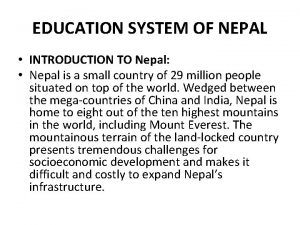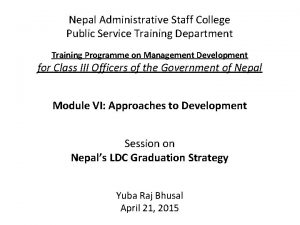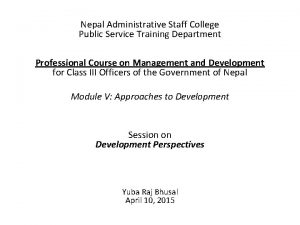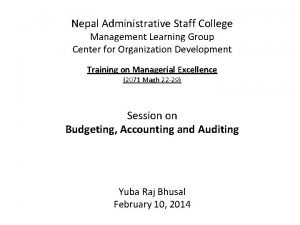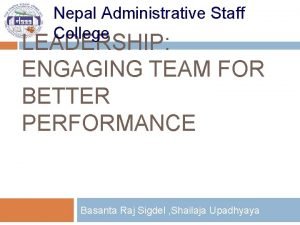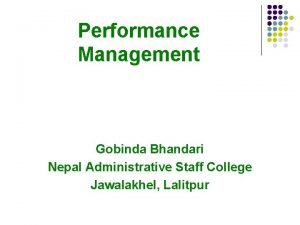Nepal Administrative Staff College Jawalakhel Lalitpur Development Planning

















- Slides: 17

Nepal Administrative Staff College Jawalakhel, Lalitpur Development Planning Process with reference to Nepal Yuba Raj Bhusal February 21, 2017

Table of Contents 1. 2. 3. 4. 5. Introduction Concept of Economic Growth The Planning Process Planned Development in Nepal The Role of National Planning Commission 6. Recent Trends in Development Planning in Nepal

1. Introduction 1. 1 Plan: deciding in advance what, how, when, who (and where) to do it! 1. 2 Development: differs by discipline. 1. 3 Development Planning: “activity that involves decisions about ends as well as means & about conduct as well as result. ” It is an organized, conscious and continual attempt to select the best available alternative to achieve specific goals.

1. 4 Types of Planning: • Level: Int’l, Regional, Sub-regional, National, Central, District, Local; • Location: Rural/Urban, Accessible/Remote; • Process: Top-down, bottom-up; lateral; • Time: Perspective, periodic, rolling and annual; • Sectoral: Physical, environmental, health, education, forestry, agricultural etc. • Instrumental: Regulatory, Allocative, Development and indicative (private sector development; • Other models: Strategic, Zero-based, Incremental.

2. Concept of Economic Growth 2. 1 Overview of socio-economic development • Hunting and gathering: egalitarian society; • Agrarian era: inequality was pervasive in the agrarian economies; • Industrial revolution (1200 -1860); • Marxist economic proposition 1848; • Socialist Planning in the Soviet Union 1928; • Great depression of 1930 s; • Keynesian Economics: public sector investment to encounter the depression.

Source: http: //en. wikibooks. org/wiki/Economic_History#mediaviewer/File: Societal_development. png

• • • • WW II and Liberation of (colonized) countries; Welfare economics of 1950 s; Growth pole concept 1955 Agro-politan development 1970 Integrated Rural Development Programs 1970 s, Women in Development (WID) 1980 s Basic Needs 1980 s Environmental 1990 s Poverty 2000 MDGs 2000 -2015 Inclusion 2010 LDC Graduation 2012 -32 SDGs 2016 -30

2. The Planning Process 2. 1 Situation Analysis/ the Diagnosis phase a) Regional Profile Analysis b) Problem/Need Analysis: Problem tree, Problem Matrix. c) Stakeholders Analysis: persons, groups, organizations/institutions vis a vis characteristics, interests, motives, attitudes, potentials and implications to the planning system. d) Potential and Constraints Analysis: natural, human, financial, infrastructures, institutional, technological and other resources and their quality, quantity, location, availability and constraints to their utilization. e) Environmental/ Social Analysis: who benefits!

2. 2 Planning/ programing phase: a) Goal and Objectives Setting: Conceive a desirable scenario/ vision; Set goal and objectives; develop strategies; determine development principles; look for the alternative course of action; and forecast resources. b) Policy Statement: Needs, philosophy, sectoral and spatial action areas. c) Program Formulation: Logframe providing a one page summary of problems, goals, objectives, programs, activities, indicators, budget, timeframe, responsibilities and assumptions.

2. 3 Implementation Design a) Implementation Planning: • Who what, when, where, how and why! • Coordinating the process- planners, beneficiaries, executing agencies, experts, resources and interest groups; • Critical Path Method: Identification, specification and refinement of activities and determining their sequences, estimating time and identifying the critical activities and delineation of the critical path. • Gantt Chart: Plan of Operations including the Annual Work Plans for progress reporting.

b) The Implementation Process: • Budget allocation • Priority setting • Business plan • Action Plan • Procurement plan • Monitoring Plan • Output, outcome, impact with activity and indicators

2. 4 Management of Implementation a) Monitoring: • Inputs, Process, Output/Outcomes; • Multiple Monitors; • Monitoring techniques: field visits, report, review meetings. b) Evaluation: • Output, Outcome, Impact; c) Re-planning: based on the feedback.

3. Planned Development in Nepal: 3. 1 Context of Nepal with regard to its Geography: Biophysical diversity Society: Population and its dynamics Economy: Livelihoods Politics: The driving force 3. 2 Need of Development Planning and its role in socio-economic transformation, 3. 3 Planned Development and the major achievements realized.

3. 3. 1 Rana period: • Juddha Sumsher’s 20 years (perspective) Plan; Industrial Council 1992 to promote agriculture, industry, commerce and the mines; • Padma Sumsher’s Perspective Plan (15 years) Formulation Committee 2005 BS; 3. 3. 2 Tribhuvan Gram Vikas Program 2008; 3. 3. 3 Government Budget 2008 BS as an instrument of public accountability;

3. 3. 4 ARPC: • Nepal embarked in planned development since 1956; • NPC with different names to date; • King Mahendra proclaimed (1955) the necessity of a five-year plan to attain national self-sufficiency and establishing a welfare state; • Consecutive Plans were in line with the global paradigms; • Consecutive Plans in line with international development paradigms.

4. The Role of National Planning Commission 4. 1 Composition: NDC and NPC: 12 Members 4. 2 Roles and Responsibilities: • Advice the GON • Perspective Plans • Periodic Plans • Annual Plans • Coordination • Monitoring and Evaluation • Program approval/amendments etc.

THANK YOU
 Nepal administrative staff college
Nepal administrative staff college Mahalaxmi municipality lalitpur
Mahalaxmi municipality lalitpur 4 sacred mountains navajo
4 sacred mountains navajo Importance of human resource development in nepal
Importance of human resource development in nepal Ministry of agriculture and livestock development nepal
Ministry of agriculture and livestock development nepal Administrative planning
Administrative planning Comberton village college staff
Comberton village college staff Cornwall college staff
Cornwall college staff Eco postal staff college
Eco postal staff college Ksk college beed staff
Ksk college beed staff Ksk college beed
Ksk college beed Engineering staff college of india
Engineering staff college of india Central transportation planning staff
Central transportation planning staff Lancashire county council hr
Lancashire county council hr Library development plan sample-philippines
Library development plan sample-philippines Alaska staff development network
Alaska staff development network Crisis development/behavior levels
Crisis development/behavior levels National staff development council
National staff development council
